The Vernal Keratoconjunctivitis Market is estimated to be valued at USD 490.9 million in 2025 and is projected to reach USD 879.1 million by 2035, registering a compound annual growth rate (CAGR) of 6.0% over the forecast period.
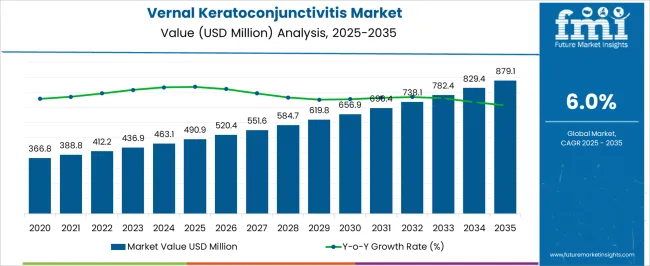
| Metric | Value |
|---|---|
| Vernal Keratoconjunctivitis Market Estimated Value in (2025 E) | USD 490.9 million |
| Vernal Keratoconjunctivitis Market Forecast Value in (2035 F) | USD 879.1 million |
| Forecast CAGR (2025 to 2035) | 6.0% |
The Vernal Keratoconjunctivitis market is progressing steadily as advancements in targeted therapies and growing awareness of chronic ocular inflammatory conditions influence treatment approaches. Increasing focus on patient-centric care and improved diagnostic capabilities are facilitating early intervention, which is pivotal for better outcomes.
Therapeutic innovations are being prioritized to enhance efficacy while minimizing side effects, particularly in pediatric and at-risk populations. The rise in prevalence, driven by environmental and genetic factors, is creating a sustained demand for specialized treatments.
Additionally, regulatory encouragement for novel drug approvals and expanded access programs are broadening patient reach. Collaborative efforts among pharmaceutical companies, healthcare providers, and advocacy groups are fostering education and awareness, which is expected to further stimulate market growth and adoption of advanced therapies in the coming years.
The market is segmented by Drug Type, Treatment, Dosage Form, and Distribution Channel and region. By Drug Type, the market is divided into Verkazia, Bertilimumab, Lodoxamide, Tacrolimus, Antolimab, Nomacopan, and Others. In terms of Treatment, the market is classified into Topical Corticosteroids, Mast Cell Stabilizers, Antihistamines, Nonsteroidal Anti-inflammatory Drugs - NSAIDs, Cyclosporine, Tacrolimus, and Others. Based on Dosage Form, the market is segmented into Gel, Ointment, Tablet, and Others. By Distribution Channel, the market is divided into Hospital Pharmacy, Retail Pharmacy, and Online Pharmacy. Regionally, the market is classified into North America, Latin America, Western Europe, Eastern Europe, Balkan & Baltic Countries, Russia & Belarus, Central Asia, East Asia, South Asia & Pacific, and the Middle East & Africa.
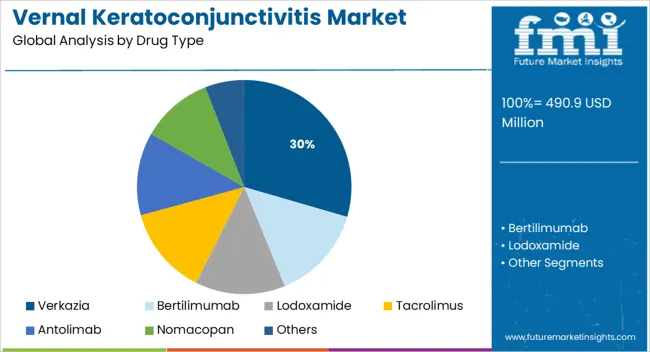
Within the drug type segmentation, Verkazia is forecast to capture 29.5% of the total market revenue in 2025, emerging as the leading drug. This dominance is attributed to its targeted mechanism of action and favorable safety profile, which have led to strong physician preference and patient adherence.
The formulation’s ability to address inflammation with reduced corticosteroid-related side effects has been a critical factor in its adoption. Further, enhanced accessibility through expanded approval in multiple regions and inclusion in treatment guidelines has solidified its market position.
The strategic emphasis on pediatric and severe vernal keratoconjunctivitis cases has also bolstered its share, with ongoing clinical programs supporting broader indications and long-term efficacy data reinforcing clinician confidence.
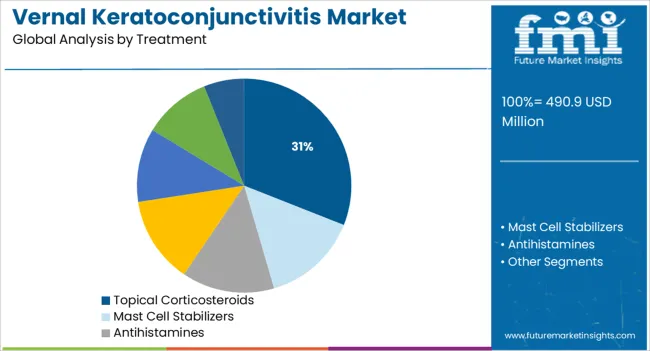
The treatment segmentation reveals topical corticosteroids holding 31.0% of the market revenue share in 2025, positioning them as the leading treatment option. Their established efficacy in rapidly reducing ocular inflammation has driven widespread use despite concerns about side effects, which are being mitigated by newer formulations and careful clinical management.
The availability of diverse corticosteroid options with varying potencies and dosing regimens has allowed customization based on disease severity, contributing to sustained utilization. Educational initiatives directed at healthcare providers regarding optimized use and monitoring have further supported their dominant role.
This segment’s leadership is reinforced by its critical place in acute management protocols and as an adjunct to other therapies, maintaining its essential status in the treatment landscape.
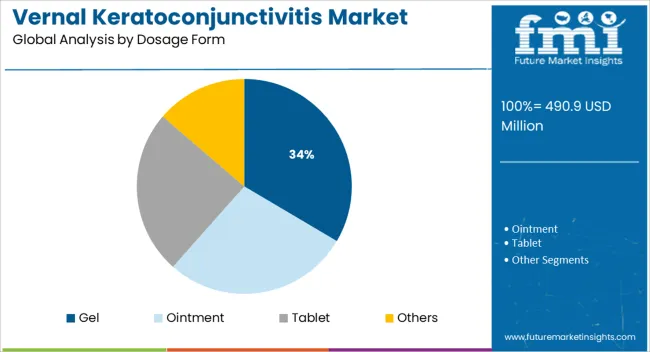
When segmented by dosage form, the gel segment is anticipated to hold 33.5% of the market revenue in 2025, making it the top dosage form. Its prominence is linked to enhanced ocular surface retention and patient comfort, which improve therapeutic outcomes and adherence.
The gel form’s ease of application and reduced frequency of administration have been influential in driving patient preference, particularly among pediatric and sensitive populations. Furthermore, formulation advances enhancing stability and reducing irritation have contributed to broader acceptance by clinicians.
The ability to deliver consistent dosing with minimal systemic absorption has strengthened the segment’s position. These factors combined have ensured the gel dosage form’s leading market share and continued growth trajectory.
According to market research and competitive intelligence provider Future Market Insights- the market for Vernal Keratoconjunctivitis reflected a value of 4% during the historical period, 2020 to 2025.
According to the NCBI article published in August 2024, conjunctivitis can manifest in COVID-19-infected people. Thus, the increasing prevalence of conjunctivitis during the pandemic had the potential to drive the demand for the market.
However, the relaxation of strict lockdowns started to contribute to the increase in the patient inflow for vernal keratoconjunctivitis treatment, adding to the growth of the market. Thus, the market for Vernal Keratoconjunctivitis is expected to register a CAGR of 6% in the forecast period 2025 to 2035.
Increasing incidence of Vernal Keratoconjunctivitis disease to push the market growth
The increasing prevalence of Vernal Keratoconjunctivitis disease is one of the biggest drivers of the market. As per the Nature article published in April 2025, approximately 10% of the sample population had allergic conjunctivitis. In India, the prevalence of allergic conjunctivitis was 12.22% among those aged between five and 15 years.
Also, the NCBI article published in January 2024 mentioned that more than half of the patients report daily symptoms as seasonal or perennial and around 75% consider their symptoms to be severe. The same source also mentioned that there were between 1.2 and 10.6 cases of vernal keratoconjunctivitis per 10,000 individuals in Europe.
With the increasing prevalence and awareness of ocular allergies has significantly increased owing to several factors such as faster urbanization and a growing number of allergens.
Treatment for vernal keratoconjunctivitis includes oral or over-the-counter (OTC) drugs that reduce the release of histamine. Also, anti-inflammatory or anti-inflammation eye drops are available quickly and are found to relieve acute conjunctivitis. Hence, this segment is expected to witness steady growth during the forecast period.
Expensive Cost of Treatment to restrict Market Growth
The expensive treatment of Vernal Keratoconjunctivitis, less awareness of Vernal Keratoconjunctivitis disease, and insubstantial treatment options are hampering the market growth.
The global conjunctivitis market is anticipated to be constrained by factors such as low illness awareness and inadequate pharmaceutical coverage in developing nations.
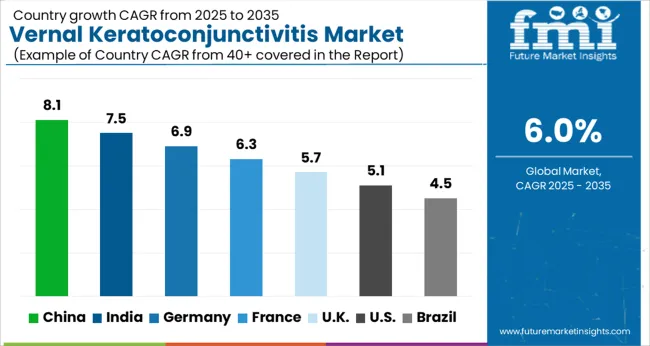
Improvement in healthcare spending propelling the growth of Vernal Keratoconjunctivitis in Asia Pacific
The Asia Pacific is expected to exhibit the fastest growth rate of all regions over the forecast period, with a CAGR of 5% during the forecast period.
The growth is owed to increased awareness, significant increases in healthcare spending, and a rising frequency of ocular allergies in the region. Conjunctivitis is quite prevalent in nations like India.
For instance, the state of Tamil Nadu reported a viral conjunctivitis issue among students and workers at schools. Clinical Epidemiology and Global Health, for instance, estimated that 12.22% of Indians suffer from ocular allergies.
The male segment is projected to have a higher prevalence (13.44%) than females (10.71%). During the projected period, these trends are anticipated to support market expansion in the region.
In addition to these factors, an increase in the frequency of infections, poor hygienic conditions in developing nations, and protracted deliveries in several of the region's countries, the Asia Pacific region is anticipated to have the third-largest share. In addition, it is anticipated that the expanding medical tourism sector in nations like Malaysia, China, and India would increase demand for treatment.
Over the anticipated time, these factors will boost market expansion in the region.
High prevalence of ophthalmic allergies shaping the landscape for Vernal Keratoconjunctivitis in North America
North America is anticipated to acquire a market share of about 20% in the forecast period. This growth is attributable to the increasing awareness of ophthalmic allergies. This, coupled with the existence of majority players, which leads to novel and advanced drug launches, and the robust spread of this disease, are factors attributing to the market's growth.
A country like the United States has a major presence of positive reimbursement policies, and this is the key reason for this region's dominance in this market.
As per the National Library Medicine article published in February 2024, conjunctivitis affects more than 6 million people across the United States every year. The estimated cost for the disease is around USD 377 million to USD 857 million per year. Conjunctivitis is found to be the most frequent disease in the country and affects 15% to 40% of the population, and is seen frequently in spring and summer.
Such prevalence of conjunctivitis in the United States is pushing the demand for an effective treatment, thereby contributing to the market's growth during the forecast period.
Key start-up players in the Vernal Keratoconjunctivitis market are-
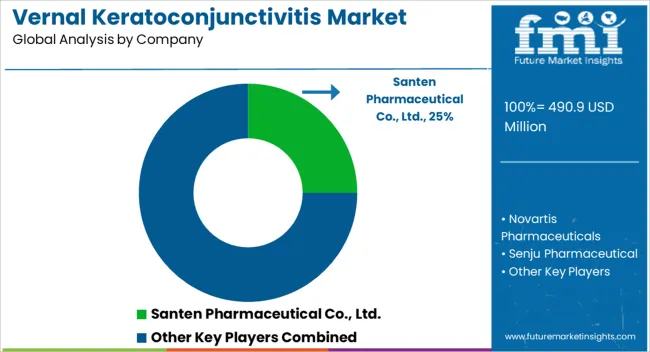
Key players in the Vernal Keratoconjunctivitis market are Allakos, iCo Therapeutics, Akari Therapeutics, and Santen.
| Report Attribute | Details |
|---|---|
| Market Value in 2025 | USD 490.9 million |
| Market Value in 2035 | USD 879.1 million |
| Growth Rate | CAGR of 6% from 2025 to 2035 |
| Base Year for Estimation | 2025 |
| Historical Data | 2020 to 2025 |
| Forecast Period | 2025 to 2035 |
| Quantitative Units | Revenue in USD Million and CAGR from 2025 to 2035 |
| Report Coverage | Revenue Forecast, Volume Forecast, Company Ranking, Competitive Landscape, Growth Factors, Trends, and Pricing Analysis |
| Segments Covered | Treatment, Drug type, Dosage Form, Distribution Channel, Region |
| Regions Covered | North America; Latin America; Europe; Asia Pacific; Middle East & Africa (MEA) |
| Key Countries Profiled | The USA, Canada, Brazil, Argentina, Germany, The UK, France, Spain, Italy, Nordics, BENELUX, Australia & New Zealand, China, India, Association of Southeast Asian Nations, GCC, South Africa |
| Key Companies Profiled | Allakos; iCo Therapeutics; Akari Therapeutics; and Santen |
| Customization | Available Upon Request |
The global vernal keratoconjunctivitis market is estimated to be valued at USD 490.9 million in 2025.
The market size for the vernal keratoconjunctivitis market is projected to reach USD 879.1 million by 2035.
The vernal keratoconjunctivitis market is expected to grow at a 6.0% CAGR between 2025 and 2035.
The key product types in vernal keratoconjunctivitis market are verkazia, bertilimumab, lodoxamide, tacrolimus, antolimab, nomacopan and others.
In terms of treatment, topical corticosteroids segment to command 31.0% share in the vernal keratoconjunctivitis market in 2025.






Our Research Products

The "Full Research Suite" delivers actionable market intel, deep dives on markets or technologies, so clients act faster, cut risk, and unlock growth.

The Leaderboard benchmarks and ranks top vendors, classifying them as Established Leaders, Leading Challengers, or Disruptors & Challengers.

Locates where complements amplify value and substitutes erode it, forecasting net impact by horizon

We deliver granular, decision-grade intel: market sizing, 5-year forecasts, pricing, adoption, usage, revenue, and operational KPIs—plus competitor tracking, regulation, and value chains—across 60 countries broadly.

Spot the shifts before they hit your P&L. We track inflection points, adoption curves, pricing moves, and ecosystem plays to show where demand is heading, why it is changing, and what to do next across high-growth markets and disruptive tech

Real-time reads of user behavior. We track shifting priorities, perceptions of today’s and next-gen services, and provider experience, then pace how fast tech moves from trial to adoption, blending buyer, consumer, and channel inputs with social signals (#WhySwitch, #UX).

Partner with our analyst team to build a custom report designed around your business priorities. From analysing market trends to assessing competitors or crafting bespoke datasets, we tailor insights to your needs.
Supplier Intelligence
Discovery & Profiling
Capacity & Footprint
Performance & Risk
Compliance & Governance
Commercial Readiness
Who Supplies Whom
Scorecards & Shortlists
Playbooks & Docs
Category Intelligence
Definition & Scope
Demand & Use Cases
Cost Drivers
Market Structure
Supply Chain Map
Trade & Policy
Operating Norms
Deliverables
Buyer Intelligence
Account Basics
Spend & Scope
Procurement Model
Vendor Requirements
Terms & Policies
Entry Strategy
Pain Points & Triggers
Outputs
Pricing Analysis
Benchmarks
Trends
Should-Cost
Indexation
Landed Cost
Commercial Terms
Deliverables
Brand Analysis
Positioning & Value Prop
Share & Presence
Customer Evidence
Go-to-Market
Digital & Reputation
Compliance & Trust
KPIs & Gaps
Outputs
Full Research Suite comprises of:
Market outlook & trends analysis
Interviews & case studies
Strategic recommendations
Vendor profiles & capabilities analysis
5-year forecasts
8 regions and 60+ country-level data splits
Market segment data splits
12 months of continuous data updates
DELIVERED AS:
PDF EXCEL ONLINE
Epidemic Keratoconjunctivitis Treatment Market Overview – Growth, Trends & Forecast 2025 to 2035

Thank you!
You will receive an email from our Business Development Manager. Please be sure to check your SPAM/JUNK folder too.
Chat With
MaRIA